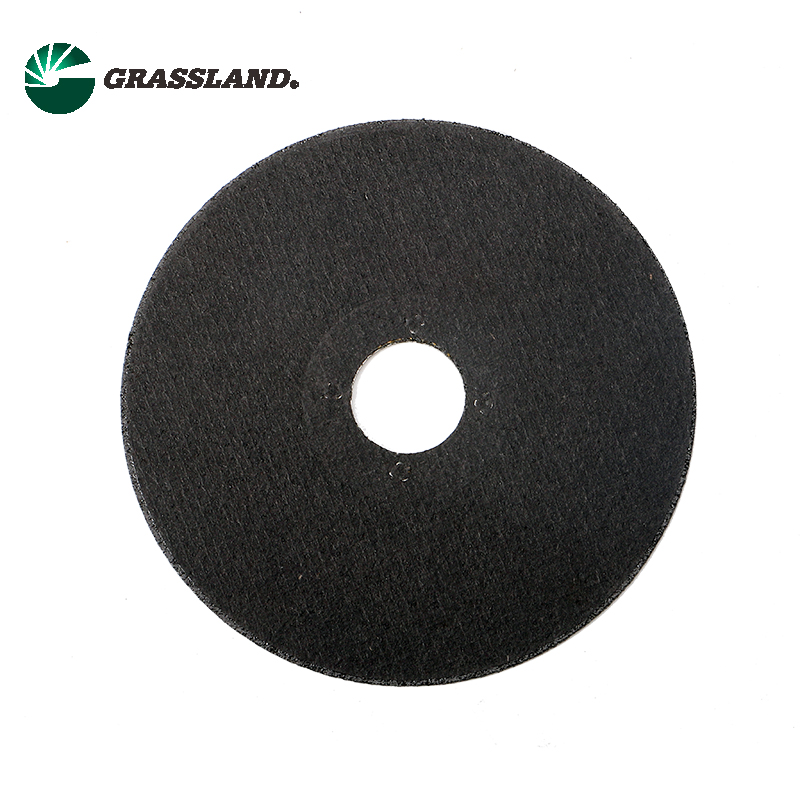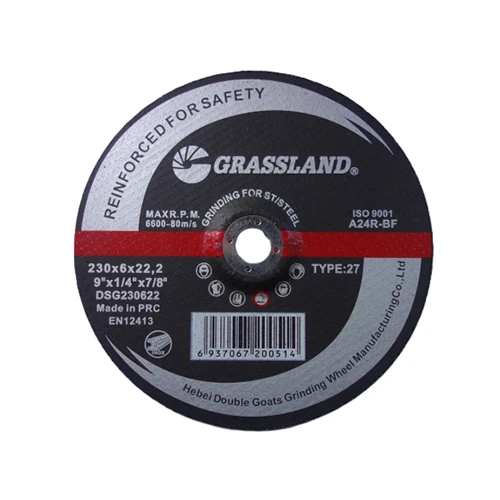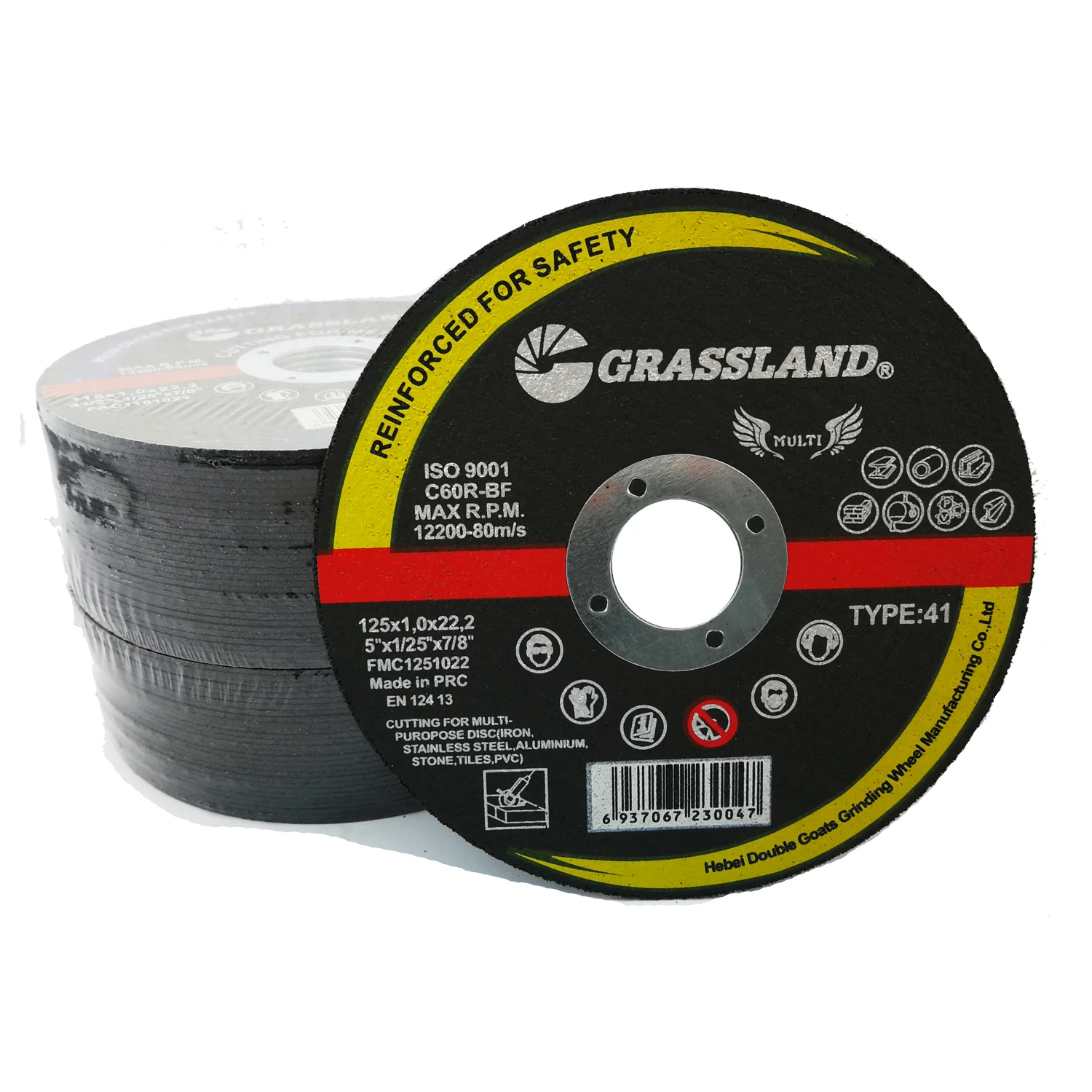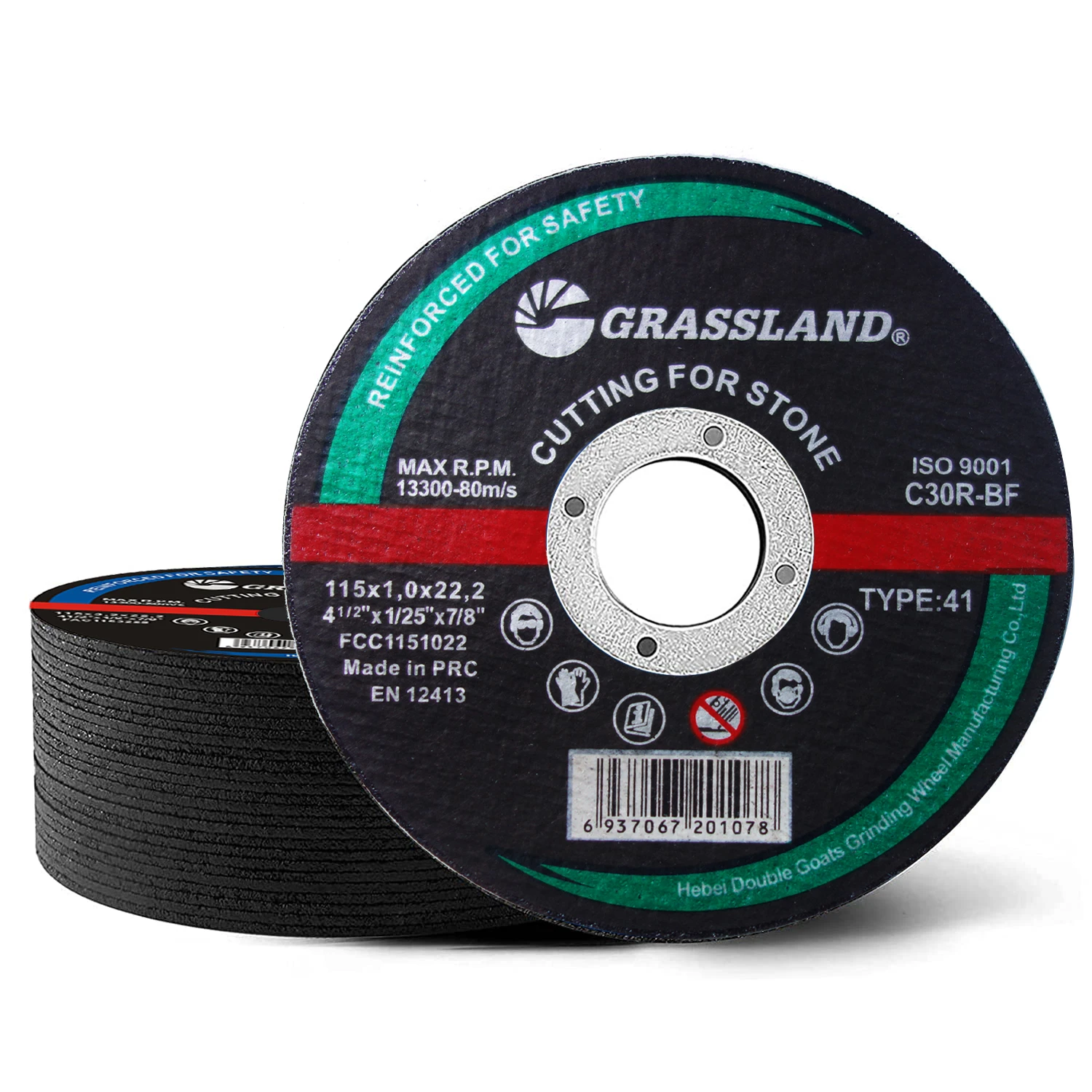Unlocking Efficiency: The Pivotal Role of stainless steel cutting discs in Modern Industrial Applications
In the rapidly evolving landscape of B2B manufacturing and fabrication, precision and efficiency are paramount. Across sectors ranging from petrochemical and metallurgy to water supply & drainage, the demand for advanced material processing tools is consistently high. Among these, abrasive cutting tools hold a critical position, with stainless steel cutting discs specifically engineered to meet the stringent requirements of processing stainless steel and other difficult-to-cut alloys. These specialized discs are designed not only for rapid material removal but also to maintain the integrity of the workpiece, preventing contamination and heat-induced distortion. The global market for abrasives, including cutting and grinding discs, is projected to reach over USD 50 billion by 2027, driven by industrial expansion and technological advancements in material science, underscoring the vital role of these components in industrial productivity.
Modern industrial trends emphasize higher productivity, enhanced safety, and reduced operational costs. This necessitates cutting solutions that offer superior service life, consistent performance, and minimal material waste. Stainless steel cutting discs address these demands by providing clean, burr-free cuts, reducing the need for extensive post-processing. Innovations in bonding technologies, abrasive grain structures, and disc reinforcement have led to significant improvements in cutting speed and durability. Furthermore, environmental considerations are increasingly influencing product development, with a focus on producing discs that generate less dust and consume less energy, aligning with global sustainability initiatives.
The Precision Engineering of Stainless Steel Cutting Discs: A Detailed Process Flow
The manufacturing of high-performance stainless steel cutting discs is a sophisticated multi-stage process, meticulously controlled to ensure adherence to international standards such as ISO 9001 for quality management and EN 12413 for safety requirements of abrasive products. This rigorous process guarantees the discs' exceptional cutting efficiency, durability, and safety in demanding industrial environments.
1. Material Selection and Preparation:
The foundation of a superior cutting disc lies in its raw materials. For INOX (stainless steel) applications, the selection of abrasive grains is critical. Aluminum Oxide (Al2O3) is commonly used, often with specific purities and crystalline structures. Zirconia Alumina (ZA) or Ceramic Alumina (CA) might be employed for more aggressive, longer-lasting discs. These grains are carefully screened for size consistency (grit size, e.g., A46, A60) and purity. The binding agent is typically a high-quality phenolic resin, known for its thermal stability and strong adhesion properties. Reinforcing fiberglass mesh, usually made from alkali-resistant glass fibers, is chosen for its tensile strength and heat resistance.
2. Mixing and Formulation:
A precise blend of abrasive grains, resin bond, and fillers (e.g., cryolite, pyrite for cooler cutting) is homogeneously mixed. This mixture directly influences the disc's hardness, friability, and cutting characteristics. The ratio is carefully calibrated to ensure optimal balance between cutting speed and disc life, specifically for the low-heat generation required when cutting stainless steel to prevent bluing or material alteration.
3. Forming and Pressing (Molding):
The prepared mixture is then spread onto layers of reinforcing fiberglass mesh. For thin cutting discs (e.g., 1.0mm, 1.6mm), multiple layers of mesh (typically two or three) are strategically placed within the abrasive matrix. This layered assembly is then subjected to high-pressure hydraulic presses. This "casting" or compression molding process compacts the mixture into the desired disc shape and density. The specific pressure and dwell time are critical for achieving uniform density and preventing voids.
4. Curing and Baking:
After pressing, the "green" discs undergo a precisely controlled thermal curing process in specialized ovens. This "forging" stage, often involving multiple temperature ramps and soak times, polymerizes the resin bond, transforming it into a hard, durable matrix that firmly encapsulates the abrasive grains and fiberglass reinforcement. This step is crucial for the disc's structural integrity, hardness, and thermal stability. Inadequate curing can lead to premature disc failure or poor cutting performance.
5. Finishing and Quality Control:
Post-curing, the discs undergo finishing operations such as center hole reaming, balancing, and labeling. Every batch is subjected to rigorous quality control tests, often exceeding ANSI B7.1 safety standards. These include:
- Rotational Burst Test: Discs are spun at speeds significantly higher than their maximum operational RPM to ensure structural integrity.
- Flexural Strength Test: To assess resistance to bending and breakage.
- Hardness Test: To ensure consistent bond strength and abrasive retention.
- Cutting Performance Test: Real-world cutting trials on stainless steel workpieces to evaluate cutting speed, disc wear rate, and cut quality (e.g., burr formation, heat discoloration).
- Dimensional Accuracy: Verification of diameter, thickness, and arbor hole dimensions.
Only discs that pass all stringent tests proceed to packaging. This meticulous process ensures a consistent service life and superior performance in target industries such as petrochemical (pipe fabrication), metallurgy (structural component trimming), and water supply & drainage (stainless steel pipeline modification). In these scenarios, the energy saving aspect comes from faster cutting times and reduced rework, while the inherent corrosion resistance of the stainless steel workpiece is maintained due to low heat input from the optimized disc formulation.

Precision manufacturing ensures consistent quality in stainless steel cutting discs.
Technical Specifications and Parameters: Grassland INOX Cutting Disc
Understanding the precise technical specifications of stainless steel cutting discs is crucial for selecting the appropriate tool for specific industrial applications. Parameters such as diameter, thickness, arbor size, maximum RPM, and material composition directly impact performance, safety, and efficiency. The "Grassland 4.5 Inch 115 Mm X 1 Mm X 22.2 Mm Inox Cutting Disc For Stainless Steel Resinoid Cut-off Wheels" is an exemplary product designed for high-precision, low-heat cutting of stainless steel.
Product Specification Table:
| Parameter | Specification (Grassland 115x1x22.2mm INOX) | Industry Standard Reference |
|---|---|---|
| Product Type | Resinoid Bonded Cut-off Wheel | EN 12413: Safety Requirements for Abrasive Products |
| Primary Abrasive Grain | High Purity Aluminum Oxide (A) | FEPA Standard (F-grain size for bonded abrasives) |
| Grit Size | A60 (Medium-Fine) | ANSI B74.18 (Abrasive Grain - Grit Sizes) |
| Bond Type | BF (Phenolic Resin Bond, Reinforced) | FEPA Standard (Bond Type Classification) |
| Hardness Grade | T (Hard) | FEPA Standard (Hardness Grade Classification) |
| Diameter | 115 mm (4.5 inches) | ISO 13942: Dimensions of grinding wheels and segments |
| Thickness | 1.0 mm (0.04 inches) | ISO 13942: Dimensions of grinding wheels and segments |
| Arbor Hole Diameter | 22.23 mm (7/8 inches) | ISO 13942: Dimensions of grinding wheels and segments |
| Max Operating Speed | 80 m/s (13300 RPM) | EN 12413 / ANSI B7.1: Safety standards for abrasives |
| Material Suitability | Stainless Steel (INOX), Acid-Resistant Steel, Thin Metals | Application-specific testing |
| Reinforcement | Double Fiberglass Mesh | Internal quality standards |
| Key Advantages | Contamination-free (Fe, S, Cl | DIN EN 12413 (for elemental composition) |
The ultra-thin profile of 1.0 mm for this particular cutting disc for stainless is optimized to minimize material loss and generate significantly less heat during cutting, which is crucial for preventing discoloration and metallurgical changes in stainless steel alloys. Its resinoid bond, reinforced with high-strength fiberglass, ensures exceptional stability and safety at high peripheral speeds up to 80 m/s. The precise grit size and hardness grade are balanced to offer aggressive material removal while maintaining excellent disc life, making it a highly efficient stainless cutting disc.
Application Scenarios and Industry Experience with Stainless Steel Cutting Wheels
The versatility and specialized design of stainless steel cutting wheels make them indispensable across a broad spectrum of industrial applications where precision, material integrity, and operational efficiency are critical. Our extensive experience working with leading manufacturers demonstrates the profound impact of high-quality cutting discs on project timelines and overall cost-effectiveness.
Typical Application Scenarios:
- Petrochemical Industry: Cutting stainless steel pipes (e.g., 304, 316L) for pipeline construction, maintenance, and modification. The low-contamination properties of INOX discs are crucial to prevent intergranular corrosion.
- Food & Beverage Processing: Fabricating and modifying stainless steel tanks, conveyors, and processing equipment. Clean cuts reduce secondary finishing and minimize surface imperfections where bacteria could harbor.
- Construction & Architectural Metalwork: Trimming and shaping stainless steel sheets, profiles, and structural elements for facades, railings, and decorative features. Achieves aesthetic, burr-free edges.
- Shipbuilding & Marine Engineering: Cutting stainless steel components for marine vessels and offshore platforms, where resistance to corrosive saltwater environments is paramount.
- Automotive Manufacturing: Custom fabrication of exhaust systems, chassis components, and specialized brackets from various stainless steel grades.
- Medical Device Manufacturing: Precision cutting of small-diameter stainless steel tubing and components, demanding minimal heat affect zone and excellent surface finish.
Customer Feedback & Service Case Details:
"Our transition to these specific cutting disc for stainless dramatically improved our fabrication throughput," states John Miller, Production Manager at Apex Fabricators. "We saw a 25% increase in cuts per disc and a significant reduction in post-cut cleanup, especially on our 304L stainless tubing. The discs cut faster and cooler, which means less material waste and fewer heat-affected zones, directly impacting our bottom line."
In a recent project for a major water treatment plant upgrade, our client, HydroSolutions Inc., faced challenges cutting thick-walled duplex stainless steel pipes (Sch 40, 6-inch diameter). Standard abrasive discs were burning through quickly and causing excessive heat. After recommending the Grassland INOX 1.0mm discs, which boast a specialized abrasive matrix for tougher alloys, HydroSolutions reported a 40% improvement in cutting speed and a 30% reduction in disc consumption. The minimal heat generation also eliminated the need for extensive cooling periods between cuts, accelerating project completion. This demonstrates not just product performance but also the value of expert consultation in optimizing industrial processes with the right stainless steel grinding disc.

Superior stainless steel cutting discs enable clean, precise cuts in critical industrial applications.
Technical Advantages of Specialized INOX Cutting Discs
The design and material composition of specialized INOX stainless steel cutting discs offer several distinct technical advantages over general-purpose abrasive wheels, particularly when working with challenging stainless steel alloys. These advantages translate directly into operational efficiencies and cost savings for B2B enterprises.
- Minimized Contamination (Fe, S, Cl-Free): Stainless steel is inherently corrosion-resistant due to its chromium content forming a passive layer. Contamination from iron, sulfur, or chlorine during cutting can compromise this layer, leading to rust spots or pitting corrosion. High-quality INOX discs are manufactured to be free of these elements (<0.1% Fe, S, Cl), ensuring the metallurgical integrity of the workpiece is preserved. This is a critical factor for applications in medical, food processing, and chemical industries.
- Low Heat Generation: Stainless steel has low thermal conductivity and can be prone to heat discoloration (bluing) and warping. Specialized INOX discs are formulated with specific abrasive grains and bond systems (e.g., cryolite fillers) that facilitate cooler cutting. This reduces heat-affected zones (HAZ), prevents material distortion, and maintains the aesthetic appearance of the stainless steel.
- Enhanced Cutting Speed and Efficiency: Optimized abrasive grain structures and bond hardness contribute to faster material removal rates. The sharp, friable grains of advanced aluminum oxide or zirconia alumina fracture precisely, presenting new sharp edges to the workpiece, leading to quicker cuts and reduced operator fatigue. This directly impacts project timelines and labor costs.
- Extended Disc Service Life: Superior bonding agents and multiple layers of fiberglass reinforcement significantly enhance the durability and wear resistance of these discs. This extended operational life reduces the frequency of disc changes, leading to less downtime and lower consumable costs over the long term, offering a significant advantage over conventional stainless steel grinding disc.
- Precision and Burr-Free Cuts: The fine grit size and thin profile (e.g., 1.0mm) of INOX discs are engineered to produce extremely clean and precise cuts with minimal burr formation. This reduces or often eliminates the need for secondary grinding or deburring operations, saving time and labor in post-processing.
- Improved Safety: Adherence to international safety standards (EN 12413, ANSI B7.1) through robust reinforcement and stringent testing ensures that INOX cutting discs operate safely at their specified maximum RPMs. This reduces the risk of disc breakage, enhancing operator safety in high-stress industrial environments.
Vendor Comparison: Evaluating Stainless Cutting Disc Performance
When sourcing stainless steel cutting discs, B2B decision-makers evaluate vendors based on a blend of product performance, reliability, safety compliance, and overall value. A comparative analysis highlights key differentiators among leading manufacturers.
Comparative Product Analysis (115x1.0x22.2mm INOX Discs):
| Feature/Vendor | Grassland INOX (Our Product) | Competitor A (Premium Brand) | Competitor B (Economy Brand) |
|---|---|---|---|
| Abrasive Grain Type | High Purity Aluminum Oxide (A) + Cooling Agents | Zirconia Alumina (ZA) / High-End Abrasive Blend | Standard Aluminum Oxide (A) |
| Contamination (Fe, S, Cl) | < 0.1% (Certified) | < 0.1% (Certified) | < 0.5% (Often Unspecified) |
| Average Cuts per Disc (on 10mm SS Bar) | ~65-70 cuts | ~70-75 cuts | ~40-50 cuts |
| Average Cutting Speed (on 3mm SS Plate) | ~3.5-4.0 seconds/cut | ~3.0-3.5 seconds/cut | ~5.0-6.0 seconds/cut |
| Heat Discoloration (on 3mm SS Plate) | Minimal | Minimal to Very Minimal | Moderate to Significant |
| Burr Formation | Very Low | Extremely Low | Moderate |
| Safety Certifications | EN 12413, ISO 9001 | EN 12413, ISO 9001, OSA, ANSI B7.1 | Often Basic or Incomplete |
| Price Point (per disc, approx.) | Mid-Range | High | Low |
While some premium brands may offer marginally higher performance in specific metrics, they often come at a significantly higher price point. Economy brands, conversely, trade off performance and critical safety features for lower costs, which can lead to higher long-term operational expenses due to increased disc consumption, slower work rates, and potential for rework. Our Grassland INOX cutting disc for stainless strikes an optimal balance, delivering near-premium performance and certified safety at a highly competitive mid-range price, maximizing return on investment for industrial users.
Customized Solutions for Specialized Stainless Steel Cutting Needs
Recognizing that standard products may not always address every unique industrial challenge, we offer customized solutions for stainless steel cutting discs. Our engineering team collaborates closely with clients to develop discs tailored to specific material types, cutting conditions, and operational requirements. This bespoke approach ensures optimal performance and efficiency for even the most demanding applications.
Customization Options Include:
- Abrasive Grain Blends: Tailoring the mix of Aluminum Oxide, Zirconia Alumina, or Ceramic Alumina for specific alloys (e.g., Duplex, Super Duplex, Hastelloy) or desired balance between cut speed and disc life.
- Bond Formulation: Adjusting resin types and fillers to optimize for heat resistance, flexibility, or specific cutting environments (e.g., wet cutting).
- Dimensions: Non-standard diameters, thicknesses, or arbor hole sizes to fit specialized cutting equipment or specific depth-of-cut requirements.
- Reinforcement: Varying the number and type of fiberglass mesh layers for enhanced safety in high-stress applications or for specific machine types.
- Application-Specific Coatings: Implementing advanced coatings to further reduce friction, heat, and material adhesion for ultra-precise or delicate operations.
Our technical team conducts thorough analysis, including material testing and simulated cutting trials, to ensure the customized stainless cutting disc meets the exact performance parameters specified by the client. This collaborative process ensures that the final product is not merely a cutting tool but a fully integrated solution enhancing productivity and material integrity.
Authoritativeness and Trustworthiness: Our Commitment to Excellence
Our dedication to quality, safety, and customer satisfaction forms the bedrock of our operations. We maintain stringent adherence to international certifications and engage in continuous improvement processes to ensure our stainless steel cutting discs consistently exceed industry expectations.
Certifications & Quality Assurance:
- ISO 9001:2015 Certified: Our manufacturing facilities and quality management systems comply with the highest international standards for quality assurance.
- EN 12413 Compliant: All our abrasive products, including the stainless steel cutting wheel range, meet the European safety requirements for bonded abrasive products.
- Fe, S, Cl-Free Certification: Independent lab tests verify that our INOX discs are virtually free of iron, sulfur, and chlorine contaminants, crucial for stainless steel integrity.
- Over 15 Years of Industry Service: With more than a decade and a half of specialized experience in abrasive manufacturing, we bring unparalleled expertise to our clients.
Lead Time, Warranty, and Support:
- Standard Lead Time: Typically 7-14 business days for in-stock items and common order quantities. Customized orders may require 3-4 weeks for production and testing.
- Warranty: All our stainless steel cutting discs are backed by a 12-month manufacturing defect warranty, guaranteeing product integrity under normal operating conditions.
- Customer Support: Our dedicated technical support team is available Monday-Friday, 9:00 AM - 5:00 PM (GMT+8), providing expert advice on product selection, application best practices, and troubleshooting. We also offer on-site technical assistance for large-scale industrial clients.
Frequently Asked Questions (FAQ) about Stainless Steel Cutting Discs
Q1: What makes an INOX cutting disc different from a standard cutting disc?
A1: INOX discs are specifically formulated for cutting stainless steel. They are designed to be free of iron, sulfur, and chlorine (<0.1% each) to prevent material contamination that could lead to corrosion. They also typically feature cooler cutting properties to prevent heat discoloration and warping of stainless steel, and often use a finer, harder abrasive grit for clean, precise cuts.
Q2: Can I use a stainless steel grinding disc for cutting applications?
A2: No. Grinding discs are significantly thicker and designed for material removal (grinding, shaping) rather than precise cutting. Using a grinding disc for cutting is dangerous and inefficient, as it can overheat, bind, and potentially shatter. Always use the correct disc for the intended application.
Q3: How do I choose the correct thickness for a cutting disc for stainless?
A3: Thinner discs (e.g., 0.8mm, 1.0mm, 1.2mm) offer faster, cleaner cuts with less material loss and heat generation, ideal for thin sheets, profiles, and precise work. Thicker discs (e.g., 1.6mm, 2.0mm, 2.5mm) provide more durability and stability for cutting thicker sections or demanding applications, though at the expense of cutting speed and increased heat. The choice depends on the material thickness and desired cut quality.
Q4: What safety precautions should be taken when using a stainless steel cutting wheel?
A4: Always wear appropriate Personal Protective Equipment (PPE), including safety glasses, hearing protection, gloves, and a face shield. Ensure the disc's maximum RPM rating is compatible with your angle grinder's speed. Inspect the disc for damage before use, secure the workpiece, and never apply excessive pressure or side grinding. Follow all manufacturer and tool safety guidelines.
Q5: What is the shelf life of a resinoid stainless cutting disc?
A5: Typically, resinoid bonded abrasive discs have a shelf life of 3-5 years from the manufacturing date, provided they are stored correctly in a dry environment, away from direct sunlight, extreme temperatures, and humidity. Improper storage can degrade the resin bond, compromising disc integrity and safety.
Conclusion: The Indispensable Role of Advanced Stainless Steel Cutting Discs
The demand for high-performance stainless steel cutting discs will only continue to grow as industries increasingly rely on stainless steel for its durability, corrosion resistance, and aesthetic appeal. The Grassland 4.5 Inch 115 Mm X 1 Mm X 22.2 Mm Inox Cutting Disc exemplifies the optimal balance of speed, precision, and longevity required by modern B2B applications. By adhering to rigorous manufacturing processes, meeting stringent technical specifications, and focusing on client-specific needs, we provide cutting solutions that not only perform but also contribute to significant operational efficiencies and cost reductions.
For B2B decision-makers and engineers, investing in specialized INOX cutting discs means ensuring the integrity of valuable stainless steel materials, optimizing fabrication workflows, and enhancing worker safety. As material science and manufacturing technologies advance, the role of these precision tools will remain central to achieving excellence in metal fabrication across diverse and critical industrial sectors.
References
- ISO. (2015). ISO 9001:2015 - Quality management systems — Requirements. International Organization for Standardization.
- European Committee for Standardization. (2014). EN 12413: Safety requirements for bonded abrasive products. CEN.
- FEPA. (2006). FEPA Standard Abrasive Grain - Grit Sizes (F-grain for bonded abrasives). Federation of European Producers of Abrasives.
- ANSI. (2017). ANSI B7.1-2017: Safety Requirements for the Use, Care, and Protection of Abrasive Wheels. American National Standards Institute.
- Mordor Intelligence. (2022). Abrasives Market - Growth, Trends, COVID-19 Impact, and Forecasts (2022 - 2027).
Post time:Sep - 14 - 2025
















